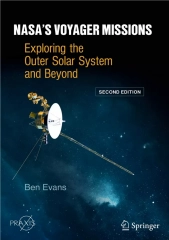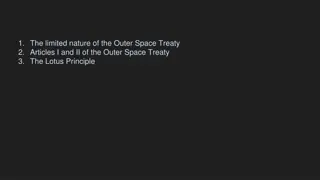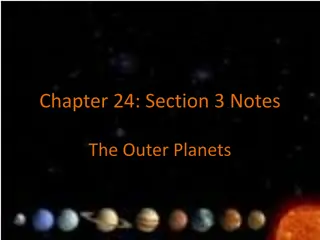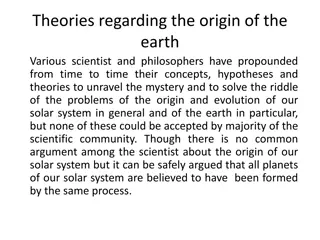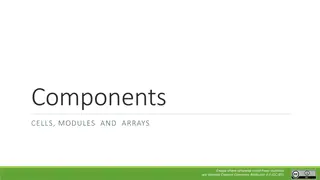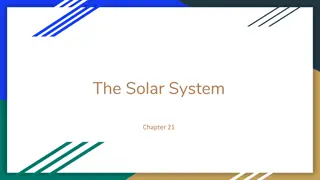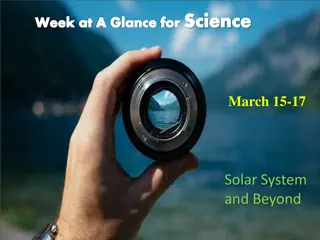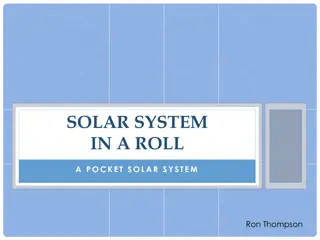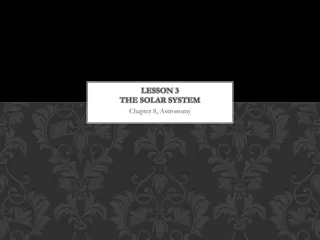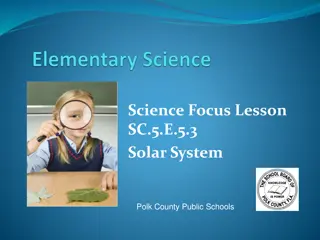Exploring the Outer Planets of the Solar System in Grade 6 Science
Discover fascinating details about Jupiter, Saturn, Uranus, and Neptune - the gas giants of our solar system. Learn about their unique characteristics, moons, rings, and distance from the Sun, providing a comprehensive understanding of these distant celestial bodies. Engage with educational resources to enhance your knowledge of the outer planets and their place in the universe.
Download Presentation

Please find below an Image/Link to download the presentation.
The content on the website is provided AS IS for your information and personal use only. It may not be sold, licensed, or shared on other websites without obtaining consent from the author. Download presentation by click this link. If you encounter any issues during the download, it is possible that the publisher has removed the file from their server.
E N D
Presentation Transcript
Natural Sciences and Technology Grade 6 Term 4: Planet Earth and Beyond The Solar System (ppt 3)
Topic 1 The Solar System The Planets Natural Sciences and Technology - Grade 6
Outer Planets Known as the gas giants. Some have many moons. Natural Sciences and Technology - Grade 6
Jupiter It is the fifth planet from the Sun and also the largest planet. First gas planet [90% hydrogen - has clouds of ammonia and 10% helium]. Mass is 318 times that of Earth. Takes 12 years to orbit the Sun. Natural Sciences and Technology - Grade 6
Jupiter Three thin dark rings, made of dust. 4 big moons and 60 smaller moons. Fast winds blow from east to west. Colour is light pink-brown. Distance from the Sun is 142 800 km. Surface temperature is -145 C. Natural Sciences and Technology - Grade 6
Saturn Saturn is the sixth planet. Gas planet of hydrogen and helium. Famous for its bright colourful rings made of frozen water. Natural Sciences and Technology - Grade 6
Saturn Furthest planet from Earth that can be seen without a telescope or binoculars. Has 62 moons. It takes 29.45 years to orbit the Sun. The average temperature is -141 C. Natural Sciences and Technology - Grade 6
Uranus A smooth blue-green gas planet. It is called an ice giant, because it is mostly made of frozen gas [hydrogen, helium and methane]. It has 9 dark and 2 brightly coloured rings. Natural Sciences and Technology - Grade 6
Uranus It has 27 known moons. Uranus turns on its axis once every 17 hours and 14 minutes. It takes 84 years to orbit the Sun. The average temperature is -216 C. Its distance from the Sun is 3 000 M km. Natural Sciences and Technology - Grade 6
Neptune It is the furthest away from the Sun. It is a gas planet. It has fast, strong winds of 1 400 km/h. Natural Sciences and Technology - Grade 6
Neptune 14 Moons. It takes 165 years to orbit the Sun. Surface temperature is -201 C. It was discovered on the 23rd September 1846. Natural Sciences and Technology - Grade 6
Dwarf Planets Dwarf planets are also known as a planetoids/plutoids. Makemake Ceres Haumea Pluto Eris Natural Sciences and Technology - Grade 6
Pluto It is no longer a planet since 2006. Largest known dwarf planet. It has an irregular orbit tilted and elongated. Surface temperature is -225 C. It has 5 moons one is very large. Natural Sciences and Technology - Grade 6
Eris Orbit period around the Sun is 560 years. It was discovered on 5th January 2005. It has only one moon, known as Disnomia. Natural Sciences and Technology - Grade 6
The Inside Story What rock planets look like inside: Natural Sciences and Technology - Grade 6
The Inside Story What gas planets look like inside: Natural Sciences and Technology - Grade 6


